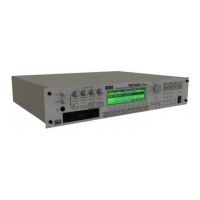5
Introduction
C-mode
[1] TEMPO:
Controls the tempo of the arpeggiator or of the
Multi mode RPPR.
[2] ARP-GATE:
Controls the gate time (note duration) of the
arpeggiated notes. At the center position (12
o’clock), the setting of the arpeggiator “Gate”
parameter will be used. Rotating the knob toward
the left will shorten the time, and rotating it
toward the right will lengthen the time.
[3] ARP-VELOCITY:
Controls the velocity (playing strength) of the
arpeggiated notes. At the center position (12
o’clock), the setting of the arpeggiator “Velocity”
parameter will be used. Rotating the knob toward
the left will weaken the velocity, and rotating it
toward the right will strengthen the velocity.
[4] ———: not used
6. [A/B/C] LEDs
The currently selected REALTIME CONTROLS
mode will light. Use the [SELECT] key to select
modes A/B/C.
7. [SELECT] key
This key selects mode A, B, or C for the realtime
controllers. Each time you press the key, the [A/B/
C] indicators at the upper left will light alternately,
and A, B, or C mode will be selected.
The indicator of this key will blink at the currently
specified tempo.
8. [ARP ON/OFF] key
This key turns the arpeggiator on/off. When on,
the LED will light.
9. [AUDITION] key
This key plays a riff (phrase) appropriate for each
of the preloaded or preset program sounds. (Audi-
tion function)
In Program mode, pressing the [AUDITION] key
to make the indicator light will cause the audition
riff to play repeatedly. In Sampling mode, this key
is used to sound the selected sample.
10. [DEMO/SNG] key
This key accesses a page where you can listen to
demo songs.
11. LCD screen
Here you can select pages, and parameters, and set
values. (
☞p.9)
12. [F1 1/9], [F2 2/10], [F3 3/11], [F4 4/12],
[F5
5/13], [F6 6/14], [F7 7/15], [F8 8/16]
keys
Function [F1]–[F8] keys
These keys select the tabs that are displayed in
each page. They are also used to execute utilities
and other functions.
Timbre/track select [1/9]–[8/16] keys
By holding down the [TIMBRE/TRACK] key and
pressing a [1/9]–[8/16] key, you can select the
parameter of the corresponding timbre/track.
When the parameters of Combination timbres 1–8
or Multi mode tracks 1–8 or 9–16 are displayed in a
single page, these keys select one of these timbres/
tracks.
13. [TIMBRE/TRACK] key
☞(The above “Timbre/track select [1/9]–[8/16]
keys”)
14. [BANK] key
This key switches between internal (INT) and
external (EXB) banks.
15. [INT/EXB] LED
This indicates whether the currently selected pro-
gram or combination is from an internal (INT) or
external (EXB) bank. The indicator will light if an
external bank (EXB) is selected. Use the [BANK]
key to switch between INT/EXB banks.
16. INT: [A], [B], [C], [D], [E-SMPL], [F-MOSS],
[G-GM] keys
EXB:[A], [B], [C], [D], [E], [F], [G], [H]
keys
In Program mode, these keys select the program
bank.
For the internal banks, pressing the [A], [B], [C],
[D], [E-SMPL], [F-MOSS], [G-GM] keys will select
INT-A (I-A), INT-B (I-B), INT-C (I-C), INT-D (I-D),
INT-E (I-E), INT-F (I-F)*, or G* banks.
* [F-MOSS] can be selected if the EXB-MOSS is
installed. Each time you press the [G-GM] key,
you will successively select G, g(1), g(2)–g(8),
g(9), g(d), G... and GM(2) variation banks and
drum banks.
For the external banks, pressing the [A], [B], [C],
[D], [E], [F], [G], or [H] keys will select the EXB-A
(E-A), EXB-B (E-B), EXB-C (E-C), EXB-D (E-D),
EXB-E (E-E), EXB-F (E-F), EXB-G (E-G), and EXB-
H (E-H) banks. Normally, the external banks are
used to load the included programs when the
EXB-PCM series options are installed.
In Combination mode, these keys select the com-
bination bank.
For the internal banks, pressing the [A], [B], [C],
[D], and [E-SMPL] keys will select INT-A (I-A),
INT-B (I-B), INT-C (I-C), INT-D (I-D), or INT-E (I-
E) banks.
For the external banks, pressing the [A], [B], [C],
12 13
16 1415

